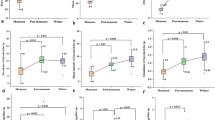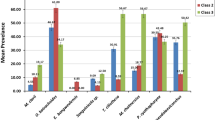Abstract
It was determined that there is a relationship between prevalence and mean densities of Trichodina spp. on Merlangius merlangus and organic pollution, measured as levels of nitrite, nitrate and phosphate in the surrounding environment. Monthly, two left anterior gill arcs of 60 M. merlangus (unless otherwise stated) captured with hook and line were fixed in 10% formalin. The number of Trichodina spp. was determined by counting all of the cells with a grid slide. The two right anterior gill arcs were used to prepare dry smears to picture the morphology of the trichodinids and to determine species composition. High levels of prevalence and densities of the protozoan were observed during the late fall, winter and early spring months. Then, prevalence decreased to lower levels but never below 60%, an indication of the important role of M. merlangus for Trichodina spp. in the studied region. A multivariate analysis revealed that the magnitude of prevalence was related to the level of all three parameters: nitrite, nitrate and phosphate (r2=0.59). However, a much stronger relationship between prevalence and nitrate, phosphate, oxygen and temperature (r2=0.89) was detected. Consequently, the seasonal parasite prevalence and density were affected by organic pollution. The timing for a high prevalence and mean densities of this parasite also suggests that primary production may be responsible for the observed seasonal variation in prevalence and mean densities. By using the model describing the relationship between the water quality parameters and the prevalence data of Trichodina spp. recalculated values and observed field data corresponded closely.

Similar content being viewed by others
References
Broeg K, Zander S, Diamant A, Korting W, Kruner G, Paperna I, Von Westernhagen H (1999) The use of fish metabolic, pathological and parasitological indices in pollution monitoring—1. North Sea Helgol Mar Res 53:171–194
Bush AO, Lafferty KD, Lotz JM, Shostak AW (1997) Parasitology meets ecology on its own terms: Margolis et al. revisited. J Parasitol 83:575–583
Dobberstein RC, Palm HW (2000) Trichodinid Ciliates (Peritrichia : Trichodinidae) From the Bay of Kiel, with Description of Trichodina Claviformis Sp N. Folia Parasitol 47:81–90
Khan RA, Thulin J (1991) Influence of pollution on parasites of aquatic animals. Adv Parasitol 30:201–238
Kuperman BI (1992) Fish parasites as bioindicators of the pollution of bodies of water. Parazitologiia 26:479–482
La Rosa T, Mirto S, Marino A, Alonzo V, Maugeri TL, Mazzola A (2001) Heterotrophic bacteria community and pollution indicators of mussel-farm impact in the Gulf of Gaeta (Tyrrhenian Sea). Mar Environ Res 52(4):301–21
Lom J (1958) Contribution to the systematics and morphology of endoparasitic trichodinids from amphibians, with a proposal of uniform specific characteristics. J Protozool 5:251–263
Lom J (1962) Trichodinid ciliates of fishes from the Rumanian Black Sea Coast. Parasitology 52:49–61
Marcogliese DJ, Cone DK (1997) Parasite communities as indicators of ecosystem stress. Parassitologia 39:227–232
McVicar AH (1997) The development of marine environmental monitoring using fish diseases. Parassitologia 39:177–181
Möller H (1987) Pollution and parasitism in the aquatic environment. Int J Parasitol 17:353–361
Murphy J, Riley JP (1962) A modified single solution method for the determination of phosphate in natural waters. Anal Chim Acta 27:31–36
Overstreet RM (1997) Parasitological data as monitors of environmental health. Parassitologia 39:169–175
Ozer A (2003) The Occurrence of Trichodina domerguei Wallengren, 1897 and Trichodina tenuidens Fauré-Fremiet, 1944 (Peritrichia) on Three-spined Stickleback, Gasterosteus aculeatus L., 1758 found in a Brackish and Freshwater Environment. Acta Protozool 42:41–46
Palm HW (2004) The Trypanorhyncha Diesing, 1863. PKSPL-IPB Press, Bogor, x + 710 pp
Palm HW, Dobberstein RC (1999) Occurence of trichodinid ciliates (Peritricha: Urceolariidae) in the Kiel Fjord, Baltic Sea, and its possible use as a biological indicator. Parasitol Res 85:726–732
Rózsa L, Reiczigel J, Majoros G (2000) Quantifying parasites in samples of hosts. J Parasitol 86:228–232
Slade CL (2001) The ecology of trichodinids (Ciliophora: Peritrichida) from southwest Java, Indonesia with taxonomic descriptions. MSc Thesis, University of Bremen, p 188
Sorohin YL (1983) The Black Sea. In: Ketchum BH (ed) Ecosystem of the world estuaries and enclosed seas. Elsevier, London, pp 253–292
Strickland JDH, Parsons TR (1968) A practical handbook of seawater analysis. Bull Fish Res Board Can 167:310
Voigt MOC (1993) Protozoan ectocommensals of toadfish and soldier crab as indicators of organic pollution in the Brisbane River estuary. University of Queensland, Queensland
Williams HH, Mackenzie K (2002) Marine parasites as pollution indicators: an update. Parasitology 126:27–41
Wood ED, Armstrong FA, Richards FA (1967) Determination of nitrate in seawater by cadmium copper reduction to nitrit. J Mar Biol Assoc UK 47:23–31
Yeomans WE, Chubb JC, Sweeting RA (1997) Use of protozoan communities for pollution monitoring. Parassitologia 39:201–212
Acknowledgements
The project was supported by Karadeniz Technical University Research fund (project# Project# 2003.117.001.5).
Author information
Authors and Affiliations
Corresponding author
Rights and permissions
About this article
Cite this article
Ogut, H., Palm, H.W. Seasonal dynamics of Trichodina spp. on whiting (Merlangius merlangus)in relation to organic pollution on the eastern Black Sea coast of Turkey. Parasitol Res 96, 149–153 (2005). https://doi.org/10.1007/s00436-005-1346-2
Received:
Accepted:
Published:
Issue Date:
DOI: https://doi.org/10.1007/s00436-005-1346-2




